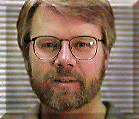

 Assistant Professor
Assistant Professor Ph.D., Speech Communication, University of Denver 1989
M.A., Mass Communication, University of Denver, 1985
B.A., Mass Communication, St. Cloud State University, 1978
Click here to go to my "personal" home page.
Background
Steve Anderson joined the department in the fall of 1995. His primary teaching and research interests are in broadcast journalism, networked multimedia (World Wide Web) and new media technologies. Before joining the department he was on the faculty at the University of Wisconsin-River Falls and Virginia Tech. At Virginia Tech he served as coordinator of the broadcast journalism sequence. In 1994, Virginia Tech awarded him a "Certificate of Teaching Excellence." The award was based on student evaluations and peer review. In 1993, Steve won two national first place awards from the National Broadcasting Society for video productions he created. Prior to entering academe, Steve was the environmental reporter and weekend weathercaster for KCNC television in Denver, Colorado where he worked between 1982 and 1989. As an environmental reporter in an "environmental state", Steve's beat included air quality and meteorological research stories among others. Prior to working in Denver, Steve was a chief news photographer, weathercaster and news reporter at stations in Fresno, California and Fargo, North Dakota. He hold a Ph.D. and an M.A. from the University of Denver and a B.A. from St. Cloud State University.
Research/Professional Activities
Steve is a member of several professional associations and currently serves as chair of the Broadcast Education Association's (BEA) Production Aesthetics & Criticism Division. He is currently serving on a "Multimedia Task Force" for BEA to help determine how multimedia is being integrated into traditional broadcasting curricula and to help make recommendations as to the role of interactive multimedia in traditional programs of communication and journalism. He also currently serves as the organization's "webmaster", creating and maintaining the BEA site on the World Wide Web.
Anderson has created (or helped create) several projects for the World Wide Web including:
- Utah Festival Opera Company:
Primary Developer. Creation of pages related to the Utah Festival Opera Company's 1996 Season. June 1996 launch.
URL is: http://www.usu.edu/~ufoc/
- Broadcast Education Association (BEA) Web Presentation.
Primary
Developer. Appointed to chair a committee of the association to design and develop
the national organization's presence on the World Wide Web.
Designed and constructed the physical layout and features of the site.
Continue to update and maintain the site as the organization's "webmaster."
September 5, 1995 launch.
URL is: http://www.usu.edu/~bea/
- Utah State University Department of Communication Web Presentation.
Primary Developer. October 10, 1995 launch.
URL is: http://www.usu.edu/~communic/
- Kansas City Chiefs Summer Training Camp Web Presentation.
Co-Developer. Worked with the University of Wisconsin-River Falls News
Bureau staff to design and develop the web presentation. July 1995 launch.
URL is: http://www.uwrf.edu/chiefs/
- UW-RF Department of Journalism WWW Project:
Sole Developer. Creation of home page and multiple self maintained links about the UW-River Falls Department of Journalism.
Fall 1994 launch.
URL is: http://www.uwrf.edu/journalism/
- On-Line Student Voice.
Creation of on-line version of the University of Wisconsin - River Falls weekly newspaper the "Student Voice". Primary Developer.
Worked with students to design and develop the online newspaper. March 1995 launch.
URL is: http://www.uwrf.edu/student-voice/
Anderson has published in several scholarly and trade publications including "Small Group Research," the "Journal of Broadcasting and Electronic Media," "Feedback," and "TV Broadcast." His current area of research deals with the development of multimedia curricula from the standpoint of desktop video, packaged multimedia and interactive multimedia over distributed networks.
Multimedia, the Internet and the World Wide Web are more than just new technologies; they are primarily
communication vehicles. The effective use of these resources requires something other than simple
technical proficiency with computers or a background in technology or engineering.
Multimedia construction and web design requires
an understanding of basic communication principles and effective message construction.
Communication students are trained to dig for resources, synthesize complex material and present information
in a form that is understandable and attractive to a wide ranging readership or audience.
Therefore,
communication education is inherently well-suited to train future multimedia designers and web creators.
Steve Anderson
"I feel that the major reason this course is so stimulating for myself & all the students is due entirely to Dr. Anderson. Never in my educational life have I had an instructor so devoted to his students. He has made the Broadcasting Dept. at Tech. Without him it would be non-existent. Students who leave his class are skilled, educated & clearly ready for the real world. I cannot praise Dr. Anderson or this class enough.
Student evaluation at Virginia Tech
The mind is not a vessel to be filled but a fire to be kindled.
Plutarch
Journalism aspirants should religiously eschew polysyllabic autography.
Source Unknown

 UP to the USU Department of Communication Home Page
UP to the USU Department of Communication Home Page
For more information about the USU Department of Communication contact Ted Pease (tpease@wpo.hass.usu.edu). For more information about this Web Site contact Steve Anderson at Utah State University (sanderso@cc.usu.edu) or Jacob Anawalt (sls5b@cc.usu.edu).